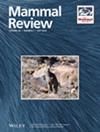使用引诱棒对欧洲野猫种群进行非侵入性基因采样:经验教训和未来启示
IF 4.4
2区 生物学
Q1 ECOLOGY
引用次数: 0
摘要
非侵入性基因采样在野生动物研究中越来越普遍。它可以在不捕捉或处理个体的情况下收集野生哺乳动物种群的第一手数据。因此,这种方法被证明特别适用于生活在低种群密度和/或难以在野外识别的难以捉摸的物种。欧洲野猫就是这方面的一个有趣案例。在过去几十年中,已经有多篇论文应用了非侵入性基因采样。然而,来自不同案例研究的证据呈现出一种复杂的情况,该方法的效率可能会有很大差异。本文旨在分析这种差异的可能解释,并找出潜在的驱动因素和障碍。本文对 20 篇相关论文进行了审查和比较,但所审查论文中报告的一些细节差异限制了深入比较。综述结果表明,研究时间与繁殖季节的重叠并不会影响对欧洲野猫的诱饵棒毛发取样研究的最终结果。此外,在大陆生态区,缬草诱饵棒一般都能提供积极的结果,而在地中海和大西洋地区,则没有或很少有结果。其他大多数工作假设尽管尚未得到明确证实,但仍然是可行的。在欧洲不同生物地理区域建立以有效的非侵入性基因采样为基础的野猫监测计划,无疑是一个需要努力的方向。在这方面,我们提出了一些建议(例如,进一步比较所需的参数集;需要测试其他类型的引诱剂,以便在使用缬草被证明无效或几乎无效的情况下应用该方法,从而更好地比较未来的结果)。本文章由计算机程序翻译,如有差异,请以英文原文为准。
Use of lure sticks for non-invasive genetic sampling of European wildcat populations: lessons learnt and hints for future insights
求助全文
通过发布文献求助,成功后即可免费获取论文全文。
去求助
来源期刊

Mammal Review
生物-动物学
CiteScore
12.20
自引率
4.10%
发文量
29
审稿时长
>12 weeks
期刊介绍:
Mammal Review is the official scientific periodical of the Mammal Society, and covers all aspects of mammalian biology and ecology, including behavioural ecology, biogeography, conservation, ecology, ethology, evolution, genetics, human ecology, management, morphology, and taxonomy. We publish Reviews drawing together information from various sources in the public domain for a new synthesis or analysis of mammalian biology; Predictive Reviews using quantitative models to provide insights into mammalian biology; Perspectives presenting original views on any aspect of mammalian biology; Comments in response to papers published in Mammal Review; and Short Communications describing new findings or methods in mammalian biology.
 求助内容:
求助内容: 应助结果提醒方式:
应助结果提醒方式:


